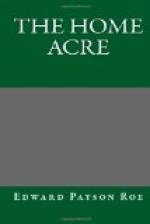In coping with insects we can act more intelligently, and therefore successfully. We can study the characters of our enemies, and learn their vulnerable points. The black and green aphides, or plant-lice, are often very troublesome. They appear in immense numbers on the young and tender shoots of trees, and by sucking their juices check or enfeeble the growth. They are the milch-cows of ants, which are usually found very busy among them. Nature apparently has made ample provision for this pest, for it has been estimated that “one individual in five generations might be the progenitor of six thousand millions.” They are easily destroyed, however. Mr. Barry, of the firm of Ellwanger & Barry, in his excellent work “The Fruit Garden,” writes as follows: “Our plan is to prepare a barrel of tobacco juice by steeping stems for several days, until the juice is of a dark brown color; we then mix this with soap-suds. A pail is filled, and the ends of the shoots, where the insects are assembled, are bent down and dipped in the liquid. One dip is enough. Such parts as cannot be dipped are sprinkled liberally with a garden-syringe, and the application repeated from time to time, as long as any of the aphides remain. The liquid may be so strong as to injure the foliage; therefore it is well to test it on one or two subjects before using it extensively. Apply it in the evening.”
The scaly aphis or bark-louse attacks weak, feeble-growing trees, and can usually be removed by scrubbing the bark with the preparation given above.
In our region and in many localities the apple-tree borer is a very formidable pest, often destroying a young tree before its presence is known. I once found a young tree in a distant part of my place that I could push over with my finger. In June a brown and white striped beetle deposits its eggs in the bark of the apple-tree near the ground. The larvae when hatched bore their way into the wood, and will soon destroy a small tree. They cannot do their mischief, however, without giving evidence of their presence. Sawdust exudes from the holes by which they entered, and there should be sufficient watchfulness to discover them before they have done much harm. I prefer to cut them out with a sharp, pointed knife, and make sure that they are dead; but a wire thrust into the hole will usually pierce and kill them. Wood-ashes mounded up against the base of the tree are said to be a preventive. In the fall they can be spread, and they at least make one of the best of fertilizers.
The codling-moth, or apple-worm, is another enemy that should be fought resolutely, for it destroys millions of bushels of fruit. In the latitude of New York State this moth begins its depredations about the middle of June. Whatever may be thought of the relation of the apple to the fall of man, this creature certainly leads to the speedy fall of the apple. Who has not seen the ground covered with premature and decaying fruit in July, August, and




